Collection of materials relating to neuro-ophthalmology as part of the Neuro-Ophthalmology Virtual Education Library.
NOVEL: https://novel.utah.edu/
TO
- NOVEL728
| Title | Creator | Description | Subject | ||
|---|---|---|---|---|---|
| 151 |
 |
Distance Visual Acuity Testing | Sean Gratton, MD | Demonstration of measuring distance visual accuity. | Visual Acuity Testing |
| 152 |
 |
Lagophthalmos | Julie Falardeau, MD; John D. Ng, MD | This is a brief PowerPoint presentation for the NANOS Examination Curriculum describing how to evaluate lagophthalmos, discussing the main causes of lagophthalmos and demonstrating few clinical examples. | Lagophthalmos; Eyelid |
| 153 |
 |
Tonometry | Ore-ofe Adesina, MD | Presentation covering the measurement of intraocular pressure, Tonometry. Covers indentation, applantation and electronic tonometry. | Tonometry; Intraocular Pressure |
| 154 |
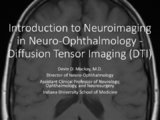 |
Diffusion Tensor Imaging (DTI) | Devin D. Mackay, MD | Explanation of using diffusion tensor imaging (DTI) in examinations. | Diffusion Tensor Imaging (DTI) |
| 155 |
 |
NExT Introduction | Sachin Kedar, MD, Editor-in-Chief | Transcript of video introduction to the NExT curriculum collection. | NANOS Examination Techniques |
| 156 |
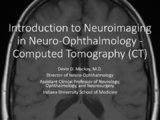 |
Computed Tomography (CT) | Devin D. Mackay, MD | Explantation of computed tomography (CT) examinations. | Computed Tomography (CT) |
| 157 |
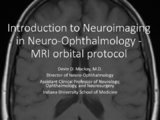 |
MRI Orbital Protocol | Devin D. Mackay, MD | Description of the MRI orbital protocol. | MRI Orbital Protocol |
| 158 |
 |
MR Angiography (MRA) | Devin D. Mackay, MD | Explanation of using MR angiography in examinations. | MR Angiography (MRA) |
| 159 |
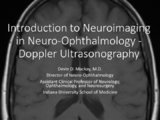 |
Doppler Ultrasonography | Devin D. Mackay, MD | Explanation of using doppler ultrasonography in examinations. | Doppler Ultrasonography |
| 160 |
 |
CT Angiography (CTA) | Devin D. Mackay, MD | Explanation of using computed tomography angiography (CTA) in examinations. | CT Angiography (CTA) |
| 161 |
 |
Paediatric Neuro-ophthalmology: Visual Acuity Assessment Strategies | Anat Bachar Zipori, MD; Nasrin Najm-Tehrani, FRCS Ed (Ophth), FRCSC | Assessing the visual function of a child can be challenging at times. When approaching a child one must understand visual development and accommodate to the child's capabilities, level of development and communication skills. The examining physician may need to apply more than one method to assess t... | Visual Acuity Assessment; Pediatric Visual Acuity Tests |
| 162 |
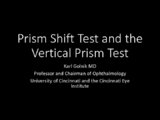 |
Prism Shift Test and the Vertical Prism Test | Karl C. Golnik, MD | Explanation of how to do the prism shift test and the vertical prism test. | Prism Shift Test; Vertical Prism Test |
| 163 |
 |
Functional MRI | Devin D. Mackay, MD | Explanation of using functional MRI in examinations. | Functional MRI |
| 164 |
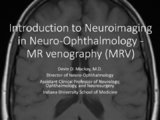 |
MR Venography (MRV) | Devin D. Mackay, MD | Explanation of using MR venography (MRV) in examinations. | MR Venography (MRV) |
| 165 |
 |
CT Venography (CTV) | Devin D. Mackay, MD | Explanation of using computed tomography venography (CTV). | CT Venography (CTV) |
| 166 |
 |
Positron Emission Tomography (PET) | Devin D. Mackay, MD | Explanation of using positron emission tomography (PET) in examinations. | Positron Emission Tomography (PET) |
| 167 |
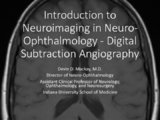 |
Digital Subtraction Angiography | Devin D. Mackay, MD | Explanation of using digital subtraction angiography in examinations. | Digital Subtraction Angiography |
| 168 |
 |
Stereo Acuity Testing for Non-physiologic Visual Loss | Walsh and Hoyt Clinical Neuro-Ophthalmology, 6th Edition; Omar Ozgur, MD; Rudrani Banik, MD; François-Xavier Borruat | Description of stereo acuity for non-physiologic visual loss. | Stereo Acuity Testing; Non-physiologic Visual Loss |
| 169 |
 |
OKN Testing for Non-physiologic Visual Loss | Walsh and Hoyt Clinical Neuro-Ophthalmology, 6th Edition | Description of OKN testing for non-physiologic visual loss. | OKN Testing; Non-physiologic Visual Loss |
| 170 |
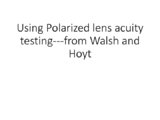 |
Using Polarized Lens Acuity Testing | Walsh and Hoyt Clinical Neuro-Ophthalmology, 6th Edition | Description of using a polarized lense for acuity testing. | Polarized Lens; Acuity Testing |
| 171 |
 |
Proprioception Testing for Non-physiologic Visual Loss | Walsh and Hoyt Clinical Neuro-Ophthalmology, 6th Edition | Description of proprioception for non-physiologic visual loss. | Proprioception Testing; Non-physiologic Visual Loss |
| 172 |
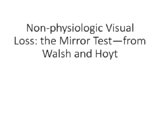 |
Mirror Test for Malingering | Walsh and Hoyt Clinical Neuro-Ophthalmology, 6th Edition | Description of the mirror test. | Mirror Test; Malingering |
| 173 |
 |
Monocular Hemianopia | Walsh and Hoyt Clinical Neuro-Ophthalmology, 6th Edition | Description of testing for a non-physiologic cause of a monocular hemianopia. | Monocular Hemianopia |
| 174 |
 |
Finger to Nose Perimetry | John Pula, MD | A description of the use of the finger to nose perimetry test is covered. | Non-organic Vision Loss |
| 175 |
 |
Double Maddox Rod Test | Nagham Al-Zubidi, MD | A description of the double maddox rod test, the equipment used and the techniques for interpreting the exam. | Double Maddox Rod Test |
